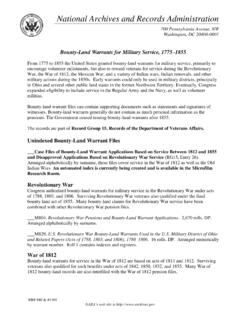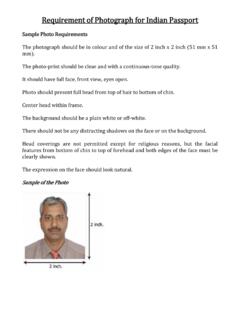Transcription of Historic American Indian Tribes of Ohio - rrcs.org
1 Historic American Indian Tribes of Ohio 1654-1843 Ohio Historical Society $ TABLE OF CONTENTS Historical background 03 Trails and Settlements 03 Shelters and Dwellings 04 Clothing and Dress 07 Arts and Crafts 08 Religions 09 Medicine 10 Agriculture, Hunting, and Fishing 11 The Fur Trade 12 Five Major Tribes of Ohio 13 Adapting Each Other s Ways 16 Removal of the American Indian 18 Ohio Historical Society Indian Sites 20
2 Ohio Historical Marker Sites 20 Timeline 32 Glossary 36 The Ohio Historical Society 1982 Velma Avenue Columbus, OH 43211 Ohio Historical Society Historic American Indian Tribes of Ohio 2 HISTORICAL background In Ohio, the last of the prehistoric indians , the Erie and the Fort Ancient people, were destroyed or driven away by the Iroquois about 1655. Some ethnologists believe the Shawnee descended from the Fort Ancient people. The Shawnees were wanderers, who lived in many places in the south. They became associated closely with the Delaware in Ohio and Pennsylvania. Able fighters, the Shawnees stubbornly resisted white pressures until the Treaty of Greene Ville in 1795. At the time of the arrival of the European explorers on the shores of the North American continent, the American indians were living in a network of highly developed cultures.
3 Each group lived in similar housing, wore similar clothing, ate similar food, and enjoyed similar tribal life. In the geographical northeastern part of North America, the principal American Indian Tribes were: Abittibi, Abenaki, Algonquin, Beothuk, Cayuga, Chippewa, Delaware, Eastern Cree, Erie, Forest Potawatomi, Huron, Iroquois, Illinois, Kickapoo, Mohicans, Maliseet, Massachusetts, Menominee, Miami, Micmac, Mississauga, Mohawk, Montagnais, Munsee, Muskekowug, Nanticoke, Narragansett, Naskapi, Neutral, Nipissing, Ojibwa, Oneida, Onondaga, Ottawa, Passamaquoddy, Penobscot, Peoria, Pequot, Piankashaw, Prairie Potawatomi, Sauk-Fox, Seneca, Susquehanna, Swamp-Cree, Tuscarora, Winnebago, and Wyandot. Ohio was occupied by numerous American Indian Tribes . In the northwest, the Wyandot were located along the banks of the Maumee and Sandusky rivers; the Shawnee, in the south were located on both sides of the Scioto; the Miami occupied the valleys of the two Miami rivers; the Mingo located in the southeast between the Muskingum and Ohio rivers, and the Delaware, Ottawa, and Chippewa people were scattered throughout.
4 TRAILS AND SETTLEMENTS The original traces or paths through the dense forests of Ohio were created by animals -such as buffalo and deer- in search of food, water, and salt licks. These trails were far enough from streams to avoid swamps and lowlands and sometimes followed the ridges, and became known as high-ways. These paths were narrow and well worn in and difficult to travel. Because of this, early people and explorers traveled single file when they used these traces to pursue game and to get flint. More efficient travel was on streams, rivers, and lakes by canoe, then, when they could go no further, travelers would portage across the land between waters. The most important trails ran north Ohio Historical Society Historic American Indian Tribes of Ohio 3and south for they connected Lake Erie with the Ohio River. Settlements grew up along the abundant natural resources near these trails and streams and because of the ease of transportation.
5 Sometime around 1583, the Spaniards introduced the horse as a means of transportation on the North American continent. Within about 100 years, the horse was ridden in the plains states to hunt buffalo. However, horses were grazers and required grasses to eat so they were not practical for the northeast as it was densely forested and lacked enough grazing areas. Grains could have been fed to the horses, but that would have meant that the American indians would have to have sacrificed their own food. It wasn t until more lands were cleared and grasses grew that horses became adaptable to the Ohio country. The trails were used successively by the American indians , explorers, the military, and settlers. Today the original Lake Trail lies under Route 20; the Great Trail blazed the way from Pittsburgh to Freemont to Detroit; and the Warrior Trail made its way from Portsmouth through Upper Sandusky, and now is the bed of Route 23.
6 SHELTERS AND DWELLINGS The teepee was generally used as a temporary shelter in a hunting camp. This cone-shaped tent had a framework of long poles placed in a circle, set upright they would lean together at the top. This frame was covered with mats or bark. Mats were made of cattails, or flags, stitched together in sections of about five by fifteen feet. These lightweight mats were easy to transport when rolled up. The wigwam was a circular, or oval, dome-shaped structure that housed one or two families. The butt-ends of the pole or sapling frame were imbedded in the earth; the tapered ends Ohio Historical Society Historic American Indian Tribes of Ohio 4were bent down and tied in place with bark strips. Over this frame was fastened a covering of bark or mats, sometimes a combination of both. Mats were made of cattails, or common marsh flags, as they were called.
7 In the center of the domed roof was a smoke hole with a section of bark on a long pole resting against the side of the wigwam that could be adjusted to keep the wind from blowing the campfire smoke back inside. Ohio Historical Society Historic American Indian Tribes of Ohio 5 The log house, another type of Woodland Indian dwelling, resembled a frontier log cabin. It had a pitched or A-shaped roof. The structure was rectangular with side walls of small logs four feet or more in height and fifteen feet long. Logs were not notched but were laid between pairs of posts driven into the ground at each end. These were tied together at the top with bark strips. End walls about twelve feet long were made of split logs set upright in the ground. Stout forked posts at either end supported the ridgepole. From the side walls to the ridge pole, small poles were laid and tied in place to serve as rafters.
8 The roof frame was covered with slabs of lynn bark, overlapped and tied in place. Cracks between the logs were stuffed with moss. Bear skins were hung over the openings at each end to serve as doors. Living quarters were on the sides; a series of small fires were laid in the middle down the length of the cabin. An opening in the roof served as a chimney. James Smith, a captive among the Ohio Wyandot and Mingo Tribes from 1755 to 1759, described such a cabin built for a winter hunting camp to house eight hunters and thirteen women and children. He commented, And not withstanding the winters are hard here, our lodging was much better than what I had expected. The longhouse design was generally associated with the Iroquois and sometimes with the Delaware and Shawnee Tribes . The longhouse was a multi-family dwelling, from thirty to more than one-hundred feet in length, and about twenty-five feet wide, and twelve to fifteen feet high.
9 The Iroquois used a rounded or Quonset-type roof, while the Delaware and Shawnee used a pitched or peaked roof. Poles and saplings bound together with tough bark strings formed the framework. This was covered with large sheets of elm or birch bark, overlapping and tied in place to make a weatherproof covering. Ohio Historical Society Historic American Indian Tribes of Ohio 6 Inside there would be a passageway down the center that contained fireplaces or pits for cooking and heating. There was a smoke hole in the roof over each fire pit. The openings at each end of the longhouse were usually covered with a large animal skin or hide. Inside, each family lived and slept on raised platforms. These platforms extended along the length of the longhouse on both sides. Placed a foot or two above the ground, these platforms were framed with poles and floored with slabs of bark. By the middle 1700s, the Delaware and Shawnee were using smaller dwellings.
10 In 1751, Christopher Gist, an explorer for the Ohio Company, visited the lower Shawnee town at the mouth of the Scioto River. According to his journal, he recounted that there were one hundred forty houses in the town, and the bark-covered council house was ninety feet long. American Indian villages could consist of as many as several hundred dwellings or cabins, or as few as a half a dozen. The villages were generally located near a stream or large spring. Good land for gardens and cornfields and a plentiful supply of firewood were important in determining the location of a village. In prehistoric times, and even after the Europeans arrived in North America, some American Indian Tribes fortified their villages with palisades, or walls, as a protection against enemy attack but by the mid-1700s, this practice had been discontinued in Ohio. In September 1772, the Reverend David McClure visited New Cornerstown located a few miles east of Coshocton on the Tuscarawas River in Ohio.








